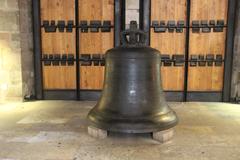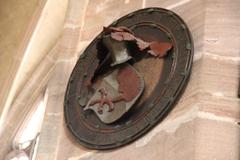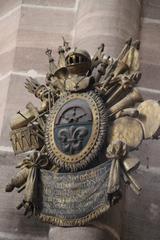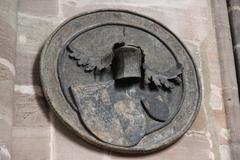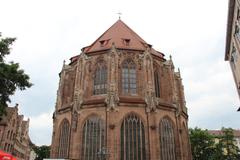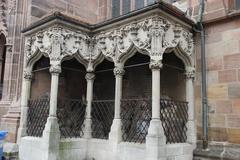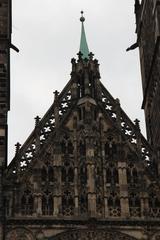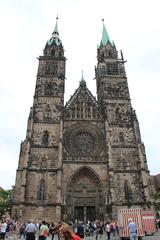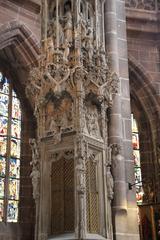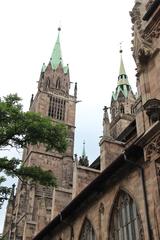
St. Lawrence Lorenzkirche Nuremberg: Visiting Hours, Tickets, and Historical Information
Date: 14/06/2025
Introduction
St. Lawrence Church (Lorenzkirche) in Nuremberg stands as a magnificent testament to the city’s medieval heritage, featuring breathtaking Gothic architecture, a rich tapestry of religious history, and vibrant cultural traditions. Famous for its twin towers, elaborate rose window, and remarkable late Gothic hall choir, the church draws visitors seeking both spiritual enrichment and an immersion into Nuremberg’s artistic legacy. Founded in the early 13th century as a modest chapel, St. Lawrence evolved through centuries of architectural innovation and civic patronage, ultimately becoming a cornerstone of the city’s identity. Its transformation into an Evangelical Lutheran parish during the Reformation in 1525 played a pivotal role in preserving its artistic treasures, making it a unique window into the interplay of faith, art, and civic pride in Germany.
This comprehensive guide offers detailed information for planning your visit, covering everything from historical context and architectural highlights to practical matters such as visiting hours, ticketing, accessibility, guided tours, and travel tips. Whether you are a history enthusiast, architecture lover, or cultural traveler, St. Lawrence Church promises a memorable and enriching experience in the heart of Nuremberg’s Old Town (Historisches Lexikon Bayerns, Nürnberg Museum, Tourismus Nürnberg).
Table of Contents
- Historical Overview
1.1 Early Origins and Foundation
1.2 Architectural Evolution
1.3 Artistic Contributions - Religious and Cultural Significance
- Notable Events and Modern Role
- Visitor Information
4.1 Visiting Hours
4.2 Tickets & Admission
4.3 Guided Tours
4.4 Accessibility
4.5 Travel Tips
4.6 Nearby Attractions
4.7 Special Events - Architectural Highlights
- Frequently Asked Questions (FAQ)
- Recommendations for Your Visit
- Conclusion
- Sources
1. Historical Overview
1.1 Early Origins and Foundation
St. Lawrence Church originated as a chapel first documented in 1235, serving the growing southern district of Nuremberg. Archaeological findings from 1929 revealed foundations of this early structure, tied to the urban development initiated under King Conrad III in the 12th century. The church was elevated to parish status in 1243, responding to the expanding Lorenzer Altstadt (Historisches Lexikon Bayerns).
1.2 Architectural Evolution
- Romanesque Beginnings: Construction of the Romanesque west section began around 1250. Over time, the church was transformed into a grand basilica, reflecting architectural trends and the ambitions of Nuremberg’s citizens.
- Gothic Transformation: In the 14th and 15th centuries, major expansions included the extension of side aisles and the completion of the south tower around 1400. Between 1439 and 1477, the renowned late Gothic hall choir was constructed under master builders Konrad Heinzelmann and the Roritzer family, exemplifying the German Sondergotik style (Nürnberg Museum).
- Artistic Contributions: The sacristy, added in 1519 by Hans Beheim the Elder, and numerous works funded by local patrons, underscore the church’s role as a civic and spiritual symbol.
1.3 Artistic Masterpieces
- The Angelic Salutation by Veit Stoss (1517–1518): A monumental limewood carving depicting the Annunciation, dramatically suspended in the choir.
- The Tabernacle by Adam Kraft (1493–1496): A nearly 20-meter-tall stone tabernacle, richly detailed and notable for featuring a self-portrait of the sculptor.
- Stained Glass Windows: The church boasts some of Germany’s finest medieval stained glass, dating from the 14th to 16th centuries.
2. Religious and Cultural Significance
St. Lawrence Church played a central role in Nuremberg’s religious and civic life, particularly after becoming an Evangelical Lutheran church in 1525. Its moderate approach to the Reformation, influenced by preacher Andreas Osiander, safeguarded much of its artistic heritage, a distinction among German churches. The building’s grandeur and its treasures reflect the competitive spirit and civic pride of Nuremberg’s merchant families, whose patronage is still evident in the church’s coats of arms and memorials (Historisches Lexikon Bayerns).
3. Notable Events and Modern Role
- Medieval to Early Modern Period: St. Lawrence hosted royal visits, imperial diets, and significant civic ceremonies.
- World War II and Restoration: The church suffered extensive damage during WWII. Thanks to early efforts to protect its treasures, many artworks survived, and the church was carefully restored in the postwar years, symbolizing resilience and commitment to heritage (SpottingHistory).
- Contemporary Role: St. Lawrence continues as a vibrant parish and cultural venue, hosting concerts, exhibitions, and ecumenical events. Its central location in the Old Town makes it a focal point for locals and tourists alike (GPSmyCity).
4. Visitor Information
4.1 Visiting Hours
- Monday to Saturday: 9:00 AM – 5:30 PM
- Sunday and Holidays: 1:00 PM – 3:30 PM
(Always consult the official website for updates, as hours may vary on holidays or during special events.)
4.2 Tickets & Admission
- Entry: Free of charge; donations are encouraged and support ongoing restoration.
- Special Exhibitions/Concerts: May require a ticket; purchase online or at the church.
4.3 Guided Tours
- Daily German tours: 2:00 PM
- Group tours: Available in English, Spanish, and Polish by advance arrangement.
- Private tours: Can be booked for a personalized experience (Tourismus Nürnberg).
4.4 Accessibility
- Fully wheelchair accessible, with ramps and accessible restrooms.
- Staff assistance available upon request.
4.5 Travel Tips
- Arrive early to avoid crowds.
- Photography for personal use is permitted, but flash and tripods are restricted.
- Dress in layers to accommodate the cool interior.
- The church is a 10-minute walk from Nuremberg Hauptbahnhof and easily reached by tram or bus.
4.6 Nearby Attractions
- St. Sebaldus Church: Another medieval landmark.
- Nuremberg Castle: Offers panoramic views of the city.
- Germanisches Nationalmuseum: A treasure trove of German art and culture.
- Christkindlesmarkt: The renowned Christmas market during Advent (Tourismus Nürnberg).
4.7 Special Events
- Regular organ concerts.
- Seasonal highlights during Advent and city-wide cultural events.
5. Architectural Highlights
West Façade and Rose Window
The impressive west façade, completed in the mid-14th century, features richly sculpted portals and a rose window nearly 9 meters in diameter—one of the defining features of German Gothic architecture.
Hall Choir and Nave
The light-filled late Gothic hall choir, constructed between 1439 and 1477, is a masterpiece of the Sondergotik style, with soaring vaults and vibrant stained glass. The church’s three-aisled basilica layout is supported by massive pillars and adorned with statues of the Apostles.
Medieval Artworks
- Angelic Salutation and Tabernacle (see above).
- Madonna of the Adoration (ca. 1285), the oldest monumental sculpture in Nuremberg.
- Tree of Life Crucifix (ca. 1430).
Organs and Musical Heritage
St. Lawrence is home to one of the world’s largest pipe organs, rebuilt after WWII, and serves as a center for sacred music and regular concerts (germanythingstodo.com).
6. Frequently Asked Questions (FAQ)
Q: What are the visiting hours for St. Lawrence Church?
A: Monday to Saturday: 9:00 AM – 5:30 PM; Sunday: 1:00 PM – 3:30 PM. Check the official site for updates.
Q: Is there an entry fee?
A: Entry is free; donations are appreciated. Tickets required for special events.
Q: Are guided tours available in English?
A: Yes, by advance arrangement.
Q: Is the church wheelchair accessible?
A: Yes, including ramps and accessible restrooms.
Q: Can I take photographs?
A: Photography is permitted for personal use, but flash/tripods may be restricted.
Q: What else should I visit nearby?
A: St. Sebaldus Church, Nuremberg Castle, Germanisches Nationalmuseum, and the Old Town.
7. Recommendations for Your Visit
- Allocate at least 1–2 hours to fully appreciate the church’s architecture and art.
- Attend an organ concert or special service for an immersive experience.
- Combine your visit with a stroll through the Old Town or the Christkindlesmarkt during Advent.
- Use the Nürnberg Card for discounts on museums and public transport (Tourismus Nürnberg).
- Explore virtual tours or high-quality images via the official website.
8. Conclusion
St. Lawrence Church stands at the crossroads of Nuremberg’s religious, artistic, and civic identity. Its soaring architecture, preserved treasures, and vibrant community life make it an essential destination for anyone seeking to experience the city’s layered heritage. Whether your interest lies in history, art, music, or spirituality, a visit to Lorenzkirche offers a memorable journey through the centuries. For updates on visiting hours, events, and guided tours, consult official channels and consider using the Audiala app for personalized travel tips. Pair your visit with explorations of nearby landmarks to deepen your understanding of Nuremberg’s fascinating story.

